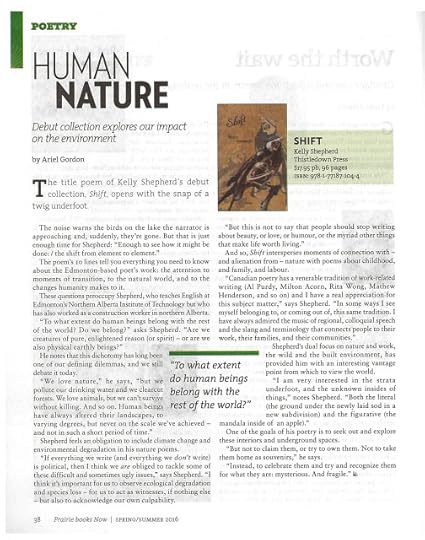Ariel Gordon's Blog, page 7
October 9, 2016
Fluid communities
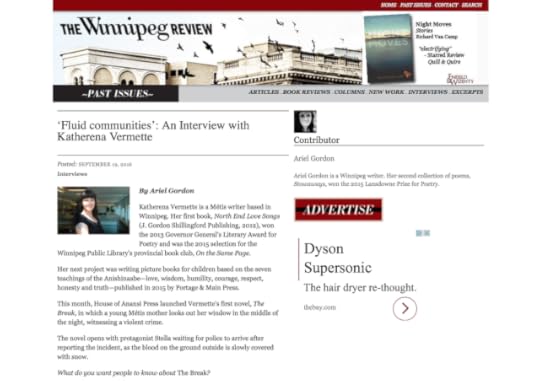
* * *
So I interviewed Winnipeg-based Metis writer Katherena Vermette about her debut novel, The Break, for the fall issue of The Winnipeg Review.
(This is my second conversation with Kate. The first was back in 2012 when her first book, North End Love Songs, was published.)
Since the interview was published, The Break has appeared on the Rogers Writers' Trust Fiction Prize and the Governor General's Award for Fiction shortlists and has been reviewed by the Globe and Mail and the National Post. Congrats to Kate!
Published on October 09, 2016 14:58
October 3, 2016
Amplifying The Call of the Forest
* * *
So I'm going to be helping to promote the feature-length documentary The Call of the Forest, amplifying the call if you will. The film features scientist and author, Diana Beresford-Kroeger, as she investigates our profound biological and spiritual connection to forests both in Manitoba and world-wide.
The Call of the Forest will be screening at Winnipeg's Cinematheque October 22-30. There will be a panel discussion after the October 22 screening and an urban forest walk on October 23.
I'm excited and proud to be working on this project and I hope you'll be interested too, having listened to me burble on about trees/forests/urban nature for ages.
So I'm going to be helping to promote the feature-length documentary The Call of the Forest, amplifying the call if you will. The film features scientist and author, Diana Beresford-Kroeger, as she investigates our profound biological and spiritual connection to forests both in Manitoba and world-wide.
The Call of the Forest will be screening at Winnipeg's Cinematheque October 22-30. There will be a panel discussion after the October 22 screening and an urban forest walk on October 23.
I'm excited and proud to be working on this project and I hope you'll be interested too, having listened to me burble on about trees/forests/urban nature for ages.
Published on October 03, 2016 19:01
October 1, 2016
Talking trees
Winnipeg Free Press—PRINT EDITIONReviewed by Ariel Gordon
You’re on a walk in Assiniboine Forest. After years of noting "that whitish tree" and "that tree with acorns," you’ve brought along a field guide — say, Lone Pine’s Plants of the Western Boreal Forest & Aspen Parkland — that helps you to identify the trees as trembling aspens and burr oaks, both of which are native to Manitoba.
When you get home, you’re still curious about the trees, so you pull Diana Beresford-Kroeger’s Arboretum Borealis: A Lifeline of the Planet from the shelf.
From one, you get descriptions of leaf shape and bark: data. From the other, you learn aspens manufacture salicylates — the source of Aspirin — and release aerosolized salicylates into the air via their rustling leaves, creating "an antiseptic for the atmosphere."
This is nature writing, a heady mixture of science and literature that not only situates the tree within the forest but also takes a moment to consider its beauty.
The most recent entry in this genre is German forester Peter Wohlleben, whose The Hidden Life of Trees: What They Feel, How They Communicate — Discoveries from a Secret World is an international bestseller. (Vancouver’s Greystone Books, in partnership with the David Suzuki Institute, has just released the English edition with a foreword by Tim Flannery, the Australian environmentalist and climate change activist.)
Before he wrote The Hidden Life of Trees, Wohlleben was a typical forester, assessing the suitability of individual trees and stands of trees for the lumber mill.
One day, he found the remains of an ancient stump, parts of which were still alive. He wondered how that was possible, without leaves or branches or even a trunk. The answer: neighbouring trees were feeding the stump sugars they’d photosynthesized via their connected roots.
Wohlleben was changed in that moment. He started living and working differently, studying the scientific literature on the "wood wide web" and closely observing the trees in his forest.
"When you know that trees experience pain and have memories and that tree parents live together with their children, then you can no longer just chop them down and disrupt their lives with large machines," he writes.
While Wohlleben worked as a forester for 20 years and his discussions of forests and trees frequently bring in current research, his use of the expression "tree parents" shows he’s fairly comfortable with anthropomorphism, which is to say he frequently attributes human characteristics such as language and memory formation to non-human organisms (trees).
Do trees talk? Well, no, not as we’ve defined it.
What is clear from the research Wohlleben draws on — including from University of British Columbia’s pioneering professor of forest ecology Dr. Suzanne Simard, who herself could write an astonishing book on trees — is trees communicate, both above and below ground. Individual trees "talk" with trees of the same species and their competitors as well as with the creatures who attempt to burrow under their bark or eat their leaves.
Terminology and analogs aside, what The Hidden Life of Trees does especially well is explain how trees function — from seed to sapling to ancient tree, from root to bark to leaf.
Wohlleben describes how different species co-exist in the forest and how they compete for space and sun and water. What’s more, he explains how trees adapt to catastrophic events such as ice storms and tornados but also to climate change. And he sugar-coats all of these explanations with a great deal of enthusiasm and fondness for his subject.
That mixture of information and storytelling, science and sentiment, is exactly what we need here in tree-loving Winnipeg, with our doomed elm canopy and our expectation the emerald ash borer will show up any minute.
A final thought, in the interest of de-anthropomorphizing this review: if Wohlleben were a tree, he’d be a beech. The forests of central Europe where he lives are dominated by beeches, so he spends a great deal of time describing them.
But don’t let that put you off. As Wohlleben notes, "your trees may not function exactly as my trees do, and your forest might look a little different, but the underlying narrative is the same: forests matter at a more fundamental level than most of us realize."
Ariel Gordon is completing a manuscript of essays about Winnipeg’s urban forest.
You’re on a walk in Assiniboine Forest. After years of noting "that whitish tree" and "that tree with acorns," you’ve brought along a field guide — say, Lone Pine’s Plants of the Western Boreal Forest & Aspen Parkland — that helps you to identify the trees as trembling aspens and burr oaks, both of which are native to Manitoba.

When you get home, you’re still curious about the trees, so you pull Diana Beresford-Kroeger’s Arboretum Borealis: A Lifeline of the Planet from the shelf.
From one, you get descriptions of leaf shape and bark: data. From the other, you learn aspens manufacture salicylates — the source of Aspirin — and release aerosolized salicylates into the air via their rustling leaves, creating "an antiseptic for the atmosphere."
This is nature writing, a heady mixture of science and literature that not only situates the tree within the forest but also takes a moment to consider its beauty.
The most recent entry in this genre is German forester Peter Wohlleben, whose The Hidden Life of Trees: What They Feel, How They Communicate — Discoveries from a Secret World is an international bestseller. (Vancouver’s Greystone Books, in partnership with the David Suzuki Institute, has just released the English edition with a foreword by Tim Flannery, the Australian environmentalist and climate change activist.)
Before he wrote The Hidden Life of Trees, Wohlleben was a typical forester, assessing the suitability of individual trees and stands of trees for the lumber mill.
One day, he found the remains of an ancient stump, parts of which were still alive. He wondered how that was possible, without leaves or branches or even a trunk. The answer: neighbouring trees were feeding the stump sugars they’d photosynthesized via their connected roots.
Wohlleben was changed in that moment. He started living and working differently, studying the scientific literature on the "wood wide web" and closely observing the trees in his forest.
"When you know that trees experience pain and have memories and that tree parents live together with their children, then you can no longer just chop them down and disrupt their lives with large machines," he writes.
While Wohlleben worked as a forester for 20 years and his discussions of forests and trees frequently bring in current research, his use of the expression "tree parents" shows he’s fairly comfortable with anthropomorphism, which is to say he frequently attributes human characteristics such as language and memory formation to non-human organisms (trees).
Do trees talk? Well, no, not as we’ve defined it.
What is clear from the research Wohlleben draws on — including from University of British Columbia’s pioneering professor of forest ecology Dr. Suzanne Simard, who herself could write an astonishing book on trees — is trees communicate, both above and below ground. Individual trees "talk" with trees of the same species and their competitors as well as with the creatures who attempt to burrow under their bark or eat their leaves.
Terminology and analogs aside, what The Hidden Life of Trees does especially well is explain how trees function — from seed to sapling to ancient tree, from root to bark to leaf.
Wohlleben describes how different species co-exist in the forest and how they compete for space and sun and water. What’s more, he explains how trees adapt to catastrophic events such as ice storms and tornados but also to climate change. And he sugar-coats all of these explanations with a great deal of enthusiasm and fondness for his subject.
That mixture of information and storytelling, science and sentiment, is exactly what we need here in tree-loving Winnipeg, with our doomed elm canopy and our expectation the emerald ash borer will show up any minute.
A final thought, in the interest of de-anthropomorphizing this review: if Wohlleben were a tree, he’d be a beech. The forests of central Europe where he lives are dominated by beeches, so he spends a great deal of time describing them.
But don’t let that put you off. As Wohlleben notes, "your trees may not function exactly as my trees do, and your forest might look a little different, but the underlying narrative is the same: forests matter at a more fundamental level than most of us realize."
Ariel Gordon is completing a manuscript of essays about Winnipeg’s urban forest.
Published on October 01, 2016 13:38
September 24, 2016
In Conversation: Lisa Moore
By Ariel GordonWinnipeg Free Press—PRINT EDITION
Lisa Moore is a writer based in St. John’s, N.L. Her novel February was long-listed for the Man Booker Prize and won Canada Reads in 2013. She is a three-time finalist for the Scotiabank Giller Prize, most recently for her novel Caught.
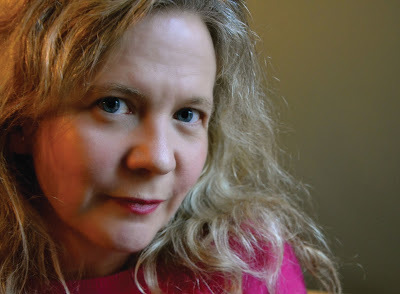 Moore will be launching her young adult novel Flannery — about a girl who manufactures love potions for her entrepreneur class that somehow seem to work — at the Winnipeg International Writers Festival on Tuesday.
Moore will be launching her young adult novel Flannery — about a girl who manufactures love potions for her entrepreneur class that somehow seem to work — at the Winnipeg International Writers Festival on Tuesday.
She spoke to Ariel Gordon via email.
Winnipeg Free Press: What do you want people to know about Flannery?
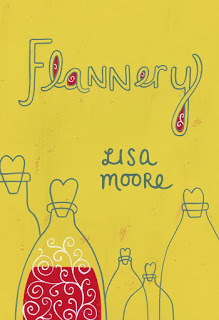 Lisa Moore: That it’s funny and set in St. John’s, N.L., and it’s about the intensity of friendship at sixteen. How powerful those friendships are, how they have the capacity to alter us forever, and how they are sometimes ephemeral. How those fast friendships can easily unfasten and cause heartbreak.
Lisa Moore: That it’s funny and set in St. John’s, N.L., and it’s about the intensity of friendship at sixteen. How powerful those friendships are, how they have the capacity to alter us forever, and how they are sometimes ephemeral. How those fast friendships can easily unfasten and cause heartbreak.
WFP: What prompted you to write young adult fiction, after two collections of short stories and three novels for adults? Put another way, what drew you to tell this story this way?
LM: Children and young adults are able to suspend disbelief as fast as a snap of the fingers. When we’re younger, the imagination is very supple and easily set in action; a few paragraphs of a novel and the imagination goes into full-on, massive fibrillation, all aquiver. It’s a beautiful power, to be able to give over to the imagination, because we can inhabit another’s skin. I think, as we get older, that muscle — the imagination — can sometimes be subject to seizing up or even atrophying. So I knew it would be a total blast to write for young adults. I loved reading young adult literature when I was young, and I loved reading it as an adult to my kids. And I wanted to try capture what it means to be sixteen in 2016.
WFP: Were there any young adult novels you looked to when writing this book?
LM: I thought about Anne of Green Gables because I once wrote an introduction to Montgomery’s novel. What I loved about that novel how uncontainable Anne is. How alive with passion and exuberance and temper tantrums. Her melodramatic love of everything. The way she smashes that slate blackboard over Gilbert’s head.
WFP: In the novel, Flannery often feels powerless. And the adults around her are preoccupied with their own problems—they seem as bewildered as she is. What does this novel say about how you build a life? About our ability to make choices?
LM: The novel tries to be honest about the way the world is for people who don’t have a lot of money. It’d be great to be able to say: Don’t worry you’ll have lots of agency if you just try hard. But of course, very often, perhaps most often, for most people, the odds are tilted in the other direction. However, there’s also lots of humour in here. I think many things, when we look them square in the eye, can be hilarious and sad at the same time.
WFP: What function do the love potions play in the book, when everyone seems to be actively looking for love, even when it’s clearly to their detriment with partners who are sometimes manipulative, even abusive. Are we that desperate for love?
LM: The love potions are mostly comedic, a tiny reference to A Midsummer Night’s Dream, and the errant, unfettered folly of desire. What dopes we become when we’re besotted. The love potions are just a gag, as Flannery herself admits. In a way, the potions make fun of the idea that love is something that happens instantly — in fact, we must be constantly learning about love, in order to love well. It requires inspiration, yes, but also work. But you’re right; I’ve also explored, in this novel, the nature of abusive or manipulative relationships. How disorienting and damaging those relationships are, how difficult to negotiate and escape — in fact, they are the opposite of love. Despite the dangers of these kinds of relationships, do I think we need to love each other? Do we need that desperately? Yes! It’s the best part of being human.
Ariel Gordon is a Winnipeg writer.
Lisa Moore is a writer based in St. John’s, N.L. Her novel February was long-listed for the Man Booker Prize and won Canada Reads in 2013. She is a three-time finalist for the Scotiabank Giller Prize, most recently for her novel Caught.
 Moore will be launching her young adult novel Flannery — about a girl who manufactures love potions for her entrepreneur class that somehow seem to work — at the Winnipeg International Writers Festival on Tuesday.
Moore will be launching her young adult novel Flannery — about a girl who manufactures love potions for her entrepreneur class that somehow seem to work — at the Winnipeg International Writers Festival on Tuesday.She spoke to Ariel Gordon via email.
Winnipeg Free Press: What do you want people to know about Flannery?
 Lisa Moore: That it’s funny and set in St. John’s, N.L., and it’s about the intensity of friendship at sixteen. How powerful those friendships are, how they have the capacity to alter us forever, and how they are sometimes ephemeral. How those fast friendships can easily unfasten and cause heartbreak.
Lisa Moore: That it’s funny and set in St. John’s, N.L., and it’s about the intensity of friendship at sixteen. How powerful those friendships are, how they have the capacity to alter us forever, and how they are sometimes ephemeral. How those fast friendships can easily unfasten and cause heartbreak.WFP: What prompted you to write young adult fiction, after two collections of short stories and three novels for adults? Put another way, what drew you to tell this story this way?
LM: Children and young adults are able to suspend disbelief as fast as a snap of the fingers. When we’re younger, the imagination is very supple and easily set in action; a few paragraphs of a novel and the imagination goes into full-on, massive fibrillation, all aquiver. It’s a beautiful power, to be able to give over to the imagination, because we can inhabit another’s skin. I think, as we get older, that muscle — the imagination — can sometimes be subject to seizing up or even atrophying. So I knew it would be a total blast to write for young adults. I loved reading young adult literature when I was young, and I loved reading it as an adult to my kids. And I wanted to try capture what it means to be sixteen in 2016.
WFP: Were there any young adult novels you looked to when writing this book?
LM: I thought about Anne of Green Gables because I once wrote an introduction to Montgomery’s novel. What I loved about that novel how uncontainable Anne is. How alive with passion and exuberance and temper tantrums. Her melodramatic love of everything. The way she smashes that slate blackboard over Gilbert’s head.
WFP: In the novel, Flannery often feels powerless. And the adults around her are preoccupied with their own problems—they seem as bewildered as she is. What does this novel say about how you build a life? About our ability to make choices?
LM: The novel tries to be honest about the way the world is for people who don’t have a lot of money. It’d be great to be able to say: Don’t worry you’ll have lots of agency if you just try hard. But of course, very often, perhaps most often, for most people, the odds are tilted in the other direction. However, there’s also lots of humour in here. I think many things, when we look them square in the eye, can be hilarious and sad at the same time.
WFP: What function do the love potions play in the book, when everyone seems to be actively looking for love, even when it’s clearly to their detriment with partners who are sometimes manipulative, even abusive. Are we that desperate for love?
LM: The love potions are mostly comedic, a tiny reference to A Midsummer Night’s Dream, and the errant, unfettered folly of desire. What dopes we become when we’re besotted. The love potions are just a gag, as Flannery herself admits. In a way, the potions make fun of the idea that love is something that happens instantly — in fact, we must be constantly learning about love, in order to love well. It requires inspiration, yes, but also work. But you’re right; I’ve also explored, in this novel, the nature of abusive or manipulative relationships. How disorienting and damaging those relationships are, how difficult to negotiate and escape — in fact, they are the opposite of love. Despite the dangers of these kinds of relationships, do I think we need to love each other? Do we need that desperately? Yes! It’s the best part of being human.
Ariel Gordon is a Winnipeg writer.
Published on September 24, 2016 16:26
September 17, 2016
In Conversation: Raina Telgemeier
By Ariel Gordon
Winnipeg Free Press—PRINT EDITION
Raina Telgemeier is a San Francisco-based graphic novelist. She’s the author of Smile (2010), Drama (2012) and Sisters (2014), all of which have been No. 1 New York Times bestsellers, as well as graphic novel adaptions of Ann M. Martin’s Baby-Sitters Club series.
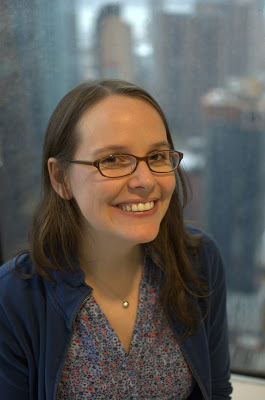 This month, Telgemeier will release Ghosts, a story told from the point of view of Cat, a tween whose family moves to northern California. Cat’s little sister Maya has cystic fibrosis, and the family hopes the climate will be better for her. The local celebration of Dia de los Muertos (Day of the Dead) figures prominently in the book, which explores mortality and loss.
This month, Telgemeier will release Ghosts, a story told from the point of view of Cat, a tween whose family moves to northern California. Cat’s little sister Maya has cystic fibrosis, and the family hopes the climate will be better for her. The local celebration of Dia de los Muertos (Day of the Dead) figures prominently in the book, which explores mortality and loss.
Winnipeg Free Press: As a comic-book artist (i.e. someone whose artistic practice is predicated on time spent alone) how do you approach readings? What do you get out of them?
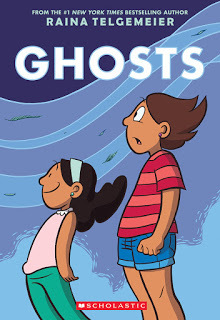 Raina Telgemeier: My public events are multifaceted. I like to bring kids up on the stage to read/dramatize scenes from my books with me; then I tell stories and show slides about my process and give the audience as much Q&A time as the venue will allow. Then I sign books and meet everyone! It’s a great way to connect directly with my readers. Every one of them is a unique and interesting person with a story to tell, and I wish I got more time with each of them, but their enthusiasm inspires me to keep writing stories.
Raina Telgemeier: My public events are multifaceted. I like to bring kids up on the stage to read/dramatize scenes from my books with me; then I tell stories and show slides about my process and give the audience as much Q&A time as the venue will allow. Then I sign books and meet everyone! It’s a great way to connect directly with my readers. Every one of them is a unique and interesting person with a story to tell, and I wish I got more time with each of them, but their enthusiasm inspires me to keep writing stories.
WFP: In Ghosts, you’ve set yourself a pretty impressive to-do list: honouring Latin culture and specifically the Day of the Dead, writing about illness and mortality in children and plumbing the sometimes contentious relationship between sisters. What was the hardest part to write for you?
RT: This book gestated in my mind for over a decade and went through many changes over the years. Every part of it was a challenge, and every part of it was rewarding to research and imagine and explore. Stepping away from memoir and realistic fiction was the hardest part. Those are my favourite genres to read and write, so adding fantasy and magic into my work was intimidating. Still, I’m at a point in my career where I want to stretch my wings and try new things — write far outside of my comfort zone. Open lots of doors and peek inside of them. Because the story deals with the idea of profound loss, it was also a place for me to explore losses within my own life through a fictional lens. It was difficult, but deeply gratifying to do so.
WFP: Were you at all worried about accusations of cultural appropriation?
RT: That’s a subject I’ve spent a great deal of time thinking about. San Francisco is an amazing melting pot, and my childhood was spent amongst a rainbow of friends from every background and culture and where I was the minority among them. I try to reflect that experience in my stories, whether it’s as a major part of the plot or within the background, and that is going to be different in every story I tell. I consider my own background and cultural identity to be "San Franciscan." How artists represent their culture and other cultures in their work is an interesting discussion, and I’m open to the conversation.
WFP: You’ve said Canadian Lynn Johnston’s For Better or For Worse is an influence of yours. What about it was important to you? That it had a female main character? That it wasn’t afraid to tackle difficult subjects, such as including the first queer character in a daily comic strip?
RT: For Better for For Worse felt like an extension of my own family, my own life. There was a voyeuristic quality to peeking in on the Pattersons’ lives every day, and I couldn’t get enough. They made me feel less alone. They felt like friends. All of the subject matter Lynn tackled, difficult or not, reflected my own life. I sometimes say, "Everything I know in life I learned from reading For Better or For Worse." It had that big of an impact on me.
WFP: It seems like the traditional trajectory for comic book artists (or graphic novelists) has changed dramatically over the past decade or so. The majority of people interested in making comics don’t aim for syndication or even traditional publishing, opting instead for web comics and some combination of Patreon/Kickstarter/comic con support from fans. But, like Jeff Smith (Bone) and Ben Hatke (Zita the Spacegirl), you’ve published your stories as graphic novels and done very well. Do you think there are more opportunities for people who want to make comics these days or less?
RT: Well, Jeff Smith started publishing Bone as a serialized comic book in the early ’90s. Smile got its start on the web in the mid-aughts. Zita the Spacegirl has roots as short web-comic vignettes, too. Most of the popular graphic novels on shelves today previously existed in other formats, whether it was on the web or in self-published books, so creators getting started now have a wealth of options for getting their work to their readers and in front of the eyeballs of editors and art directors. These days, there seems to be more of a demand for comics than ever.
WFP: Have you been to Winnipeg before? What have you heard?
RT: First time in Winnipeg! I’ve heard there are big skies and friendly people. Sounds good to me.
WFP: What are you reading right now?
RT: I’m reading Martha Brockenbrough’s novel The Game of Love and Death and a couple of non-fiction titles. As for writing, I’m working on my next book, which will be another memoir. That’s all I can say about it at the moment.
Ariel Gordon is a Winnipeg writer.
Winnipeg Free Press—PRINT EDITION
Raina Telgemeier is a San Francisco-based graphic novelist. She’s the author of Smile (2010), Drama (2012) and Sisters (2014), all of which have been No. 1 New York Times bestsellers, as well as graphic novel adaptions of Ann M. Martin’s Baby-Sitters Club series.
 This month, Telgemeier will release Ghosts, a story told from the point of view of Cat, a tween whose family moves to northern California. Cat’s little sister Maya has cystic fibrosis, and the family hopes the climate will be better for her. The local celebration of Dia de los Muertos (Day of the Dead) figures prominently in the book, which explores mortality and loss.
This month, Telgemeier will release Ghosts, a story told from the point of view of Cat, a tween whose family moves to northern California. Cat’s little sister Maya has cystic fibrosis, and the family hopes the climate will be better for her. The local celebration of Dia de los Muertos (Day of the Dead) figures prominently in the book, which explores mortality and loss.Winnipeg Free Press: As a comic-book artist (i.e. someone whose artistic practice is predicated on time spent alone) how do you approach readings? What do you get out of them?
 Raina Telgemeier: My public events are multifaceted. I like to bring kids up on the stage to read/dramatize scenes from my books with me; then I tell stories and show slides about my process and give the audience as much Q&A time as the venue will allow. Then I sign books and meet everyone! It’s a great way to connect directly with my readers. Every one of them is a unique and interesting person with a story to tell, and I wish I got more time with each of them, but their enthusiasm inspires me to keep writing stories.
Raina Telgemeier: My public events are multifaceted. I like to bring kids up on the stage to read/dramatize scenes from my books with me; then I tell stories and show slides about my process and give the audience as much Q&A time as the venue will allow. Then I sign books and meet everyone! It’s a great way to connect directly with my readers. Every one of them is a unique and interesting person with a story to tell, and I wish I got more time with each of them, but their enthusiasm inspires me to keep writing stories.WFP: In Ghosts, you’ve set yourself a pretty impressive to-do list: honouring Latin culture and specifically the Day of the Dead, writing about illness and mortality in children and plumbing the sometimes contentious relationship between sisters. What was the hardest part to write for you?
RT: This book gestated in my mind for over a decade and went through many changes over the years. Every part of it was a challenge, and every part of it was rewarding to research and imagine and explore. Stepping away from memoir and realistic fiction was the hardest part. Those are my favourite genres to read and write, so adding fantasy and magic into my work was intimidating. Still, I’m at a point in my career where I want to stretch my wings and try new things — write far outside of my comfort zone. Open lots of doors and peek inside of them. Because the story deals with the idea of profound loss, it was also a place for me to explore losses within my own life through a fictional lens. It was difficult, but deeply gratifying to do so.
WFP: Were you at all worried about accusations of cultural appropriation?
RT: That’s a subject I’ve spent a great deal of time thinking about. San Francisco is an amazing melting pot, and my childhood was spent amongst a rainbow of friends from every background and culture and where I was the minority among them. I try to reflect that experience in my stories, whether it’s as a major part of the plot or within the background, and that is going to be different in every story I tell. I consider my own background and cultural identity to be "San Franciscan." How artists represent their culture and other cultures in their work is an interesting discussion, and I’m open to the conversation.
WFP: You’ve said Canadian Lynn Johnston’s For Better or For Worse is an influence of yours. What about it was important to you? That it had a female main character? That it wasn’t afraid to tackle difficult subjects, such as including the first queer character in a daily comic strip?
RT: For Better for For Worse felt like an extension of my own family, my own life. There was a voyeuristic quality to peeking in on the Pattersons’ lives every day, and I couldn’t get enough. They made me feel less alone. They felt like friends. All of the subject matter Lynn tackled, difficult or not, reflected my own life. I sometimes say, "Everything I know in life I learned from reading For Better or For Worse." It had that big of an impact on me.
WFP: It seems like the traditional trajectory for comic book artists (or graphic novelists) has changed dramatically over the past decade or so. The majority of people interested in making comics don’t aim for syndication or even traditional publishing, opting instead for web comics and some combination of Patreon/Kickstarter/comic con support from fans. But, like Jeff Smith (Bone) and Ben Hatke (Zita the Spacegirl), you’ve published your stories as graphic novels and done very well. Do you think there are more opportunities for people who want to make comics these days or less?
RT: Well, Jeff Smith started publishing Bone as a serialized comic book in the early ’90s. Smile got its start on the web in the mid-aughts. Zita the Spacegirl has roots as short web-comic vignettes, too. Most of the popular graphic novels on shelves today previously existed in other formats, whether it was on the web or in self-published books, so creators getting started now have a wealth of options for getting their work to their readers and in front of the eyeballs of editors and art directors. These days, there seems to be more of a demand for comics than ever.
WFP: Have you been to Winnipeg before? What have you heard?
RT: First time in Winnipeg! I’ve heard there are big skies and friendly people. Sounds good to me.
WFP: What are you reading right now?
RT: I’m reading Martha Brockenbrough’s novel The Game of Love and Death and a couple of non-fiction titles. As for writing, I’m working on my next book, which will be another memoir. That’s all I can say about it at the moment.
Ariel Gordon is a Winnipeg writer.
Published on September 17, 2016 16:30
September 8, 2016
Advanced heckling
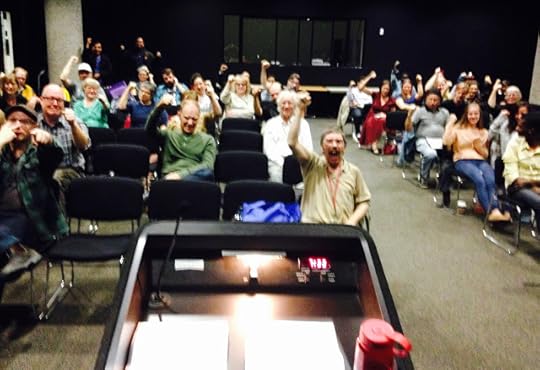
* * *
So I asked the audience at Speaking Crow to pretend to be an angry mob. Because I thought it would make my friends laugh. It turns out that I was laughing too hard myself to take a good pic. Oh well...
I read Poetry Barter Project poems and had people join me on stage where appropriate: Julie Kentner read the lists in "Fire Baggage," one of three poems I wound up writing for her, and host poet Steve Locke read the interstitial bits in "For a sheaf of grape leaves."
It was a fun evening....
Published on September 08, 2016 17:49
September 3, 2016
Speaking Crow THIS TUESDAY

"Crow is back from a short break with an exciting reading from Ariel Gordon! September is National Honey Month, so you know it'll be a sweet time.
Sign up for the open mic, or participate as an audience member. Carol Shields Auditorium. Performers have a strictly enforced 3 minute time limit. Sign-up at 7, show at 7:15.
To ease the transition from Chim to Bruce, we're bringing in Everyone's Favourite Steve Locke, Steve Locke! The natural halfway point between two other bespectacled people.
Speaking Crow is always a treat, and a free one, at that."
* * *
So I'll be reading as part of the Speaking Crow Reading Series this Tuesday, which is Winnipeg's longest-running reading series.
I'm going to be reading some of my Poetry Barter Project poems, so if you're interested in food, urban nature, and occasional poems, this is the evening for you!
Published on September 03, 2016 13:58
August 16, 2016
Out-of-Town-Authors: Kerry Gilbert
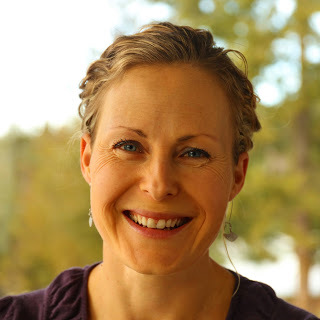 I don't think I've met Vernon-based poet Kerry Gilbert before.
I don't think I've met Vernon-based poet Kerry Gilbert before.I know several people in her writing group and in the broader northern BC literary community. Partly that's because I read in Vernon and Kelowna back in 2013.
Partly it's because I value my relationships with women writers who live outside of of the 'poetry hotbeds' of Toronto and Vancouver and especially women writers who have children.
Over the last ten-fifteen years, I've befriended women/writers and then writer/mothers at conferences, at joint readings, and at retreats. And I've worked to maintain those relationships, not just because I admire their writing but because I like the idea that we're all writing in tandem.
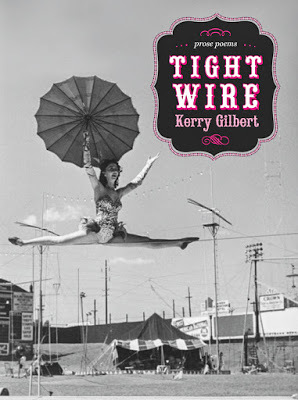 I like that we can swerve into each other's paths as necessary. For a quick and dirty edit, for midnight chats on Facebook about everything and nothing, for commiseration when things get hard. And when there's something to celebrate, like a shortlisting for a contest or a residency or a new book, I'm loud/proud.
I like that we can swerve into each other's paths as necessary. For a quick and dirty edit, for midnight chats on Facebook about everything and nothing, for commiseration when things get hard. And when there's something to celebrate, like a shortlisting for a contest or a residency or a new book, I'm loud/proud.So, when Kerry 'friended' me and then asked for my advice on promoting her latest book, Tight Wire, it quickly became obvious that I should interview her. Because even though we've never met, I recognize her.
Hey Kerry. What do you want people to know about Tight Wire?
Tight Wire came out of a place of imbalance. I was trying to manage that illusive parenting / working / writing balance and it wasn’t going well. I wasn’t writing at all, actually, and many of the poems erupted from that lack—a rebellion.
Speaking of rebellion, the circus and the carnival are central to this collection. They had a very particular idea of the feminine, didn’t they? Women were either exaggeratedly or transgressively feminine: the tightrope walker (“beauty. sequins. perfection. poise.”) or the tattooed lady (“how could this happen to you?”). Tell me how you found yourself at the circus…
I was/am really interested in the arbitrary nature of gender expectations and of the feminine on display. In the circus we normalize and celebrate abnormal behavior, which served as a fantastic metaphor for these things. There is something about the show of outward appearance—of holding things together—versus an inward falling apart that has always interested me. While trying to balance the work / writing / family life, I felt suddenly submerged in a kind of circus and yet everyone just kept smiling painted-on smiles as if everything was just fine.
This collection is also about women in danger. Women—mothers—sacrifice themselves for their children, for children who in some cases are “already saved.” Women find that their bodies are made of clay or seaweed. Is this a nod to all the transformations, all the transmogrifications, of pregnancy and mothering?
Yes, it’s a nod to the contortionists in most of us. I know some of the women in this book. Some of them are me. Some of them are women that I’ve never met, but their own anecdotes echo as a warning of what happens when we spread ourselves too thin with expectations, trying to put on this lovely, grotesque show.
What were your goals for Tight Wire?
There was a moment, very early on in the manuscript, where I was feeling really, really frustrated / stagnant / resentful / burnt out as a person; the poet in me said: what does this look like? The poem “with a tiny scalpel, she carefully cuts the skin just underneath her blouse line. down the sides to her hips. to her ankles. around and up her inner thighs—both sides” came out of that question. For me, it captured all of my abstract “angst” into something concrete and tangible. The rest of the collection was a succession of different versions of the same question—what does this look like?
Which leads me to my next question. In addition to the ‘what does this look like’ moment in “with a tiny scalpel…” there are all kinds of surgeries in the book, all kinds of interventions, from childbirth to hysterectomies. There are also a number of hearts in jars…
All of the surgeries and interventions and scalpels are really about loss. I don’t think we can truly find balance without letting things go. Cutting things out. Having things taken away. Faking the real thing and hoping it’s good enough.
What does guilt do to your writing? Feed it or starve it?
In the case of Tight Wire, it fueled the manuscript and the urgency I felt to write at the time helped create the style/tone. If I take myself too seriously, though, guilt (and fear) could certainly starve it.
In terms of craft, tell me why you’ve gravitated towards the prose-poetry form. Does a prose-y line have more bounce for you than a standard line of poetry?
This is the first time I’ve worked in all prose for a collection. The theme and tone needed the denseness of the form, for me. And, because balance became central, the juxtaposition of the single line on the left side of the page made the prose all that much more important on the right.
Now that Tight Wire is out, have you found your ideas around balancing your time between teaching AND raising a family AND trying to write have changed?
This is a work in progress. I’m getting better at valuing all of those acts equally, which is going against the grain (society only truly values the one that makes money).
What is the arts community like in the Okanagan compared to the other places you’ve lived?
The Okanagan has a vibrant writing community, and many talented writers calling it home, but you have to work at outwardly finding it here more than other places. Maybe that makes it all the more rewarding and special when you find it.
You’ve found a writing group within that community, yes? Tell me how being in a group influences your process. In the case of this book, did it help that the people giving you feedback were also writer / mothers?
Yes, I am very grateful to be part of a seven woman writing group, called Spoke. It is absolutely central to my process, in that it keeps me accountable, productive and humble. As a group we share the ups and downs of this whole writing business, which is a great reminder that there are both. I value their feedback and support for this book and for many other things. These talented women inspire me to keep writing, no matter what.
What are you reading right now? What are you writing right now?
I’m reading Hannah Calder’s Piranesi’s Figures for fiction and Lorna Crozier’s The Wrong Cat for poetry. I’m working on two different poetry manuscripts—one on fear and parenting and one on women and education. I’ve said too much. :)
Published on August 16, 2016 00:17
August 15, 2016
I've been Matilda Magtree-d!
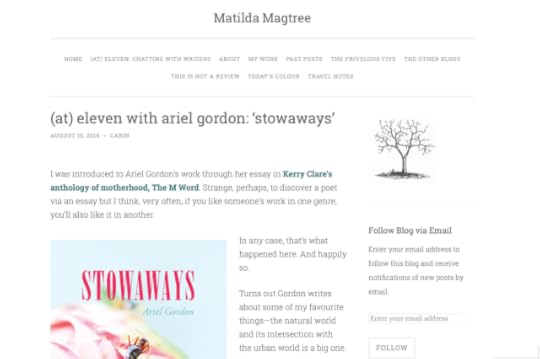
* * *
Carin Makuz, who blogs as Matilda Magtree and also runs the Litter-I-See Project, recently interviewed me about Stowaways.
It was a great, sprawling, summery interview. (She's also interviewed Brenda Schmidt and Tracy Hamon, among others, whose interviews you can check out here.)
My thanks to Carin for keeping me company while I was on retreat in The Pas!
Published on August 15, 2016 13:11
August 11, 2016
PBN: Kelly Shepherd
Published on August 11, 2016 21:45

